If you think driveways don’t have any significant impact on your property, we want you to think again.
Aside from providing a smooth parking experience, a driveway can add value to the house. And if it’s a cement driveway, then you have hit the jackpot! But building one is easier said than done. Some basic research will lead you to a plethora of options, thereby inviting confusion and fatigue.
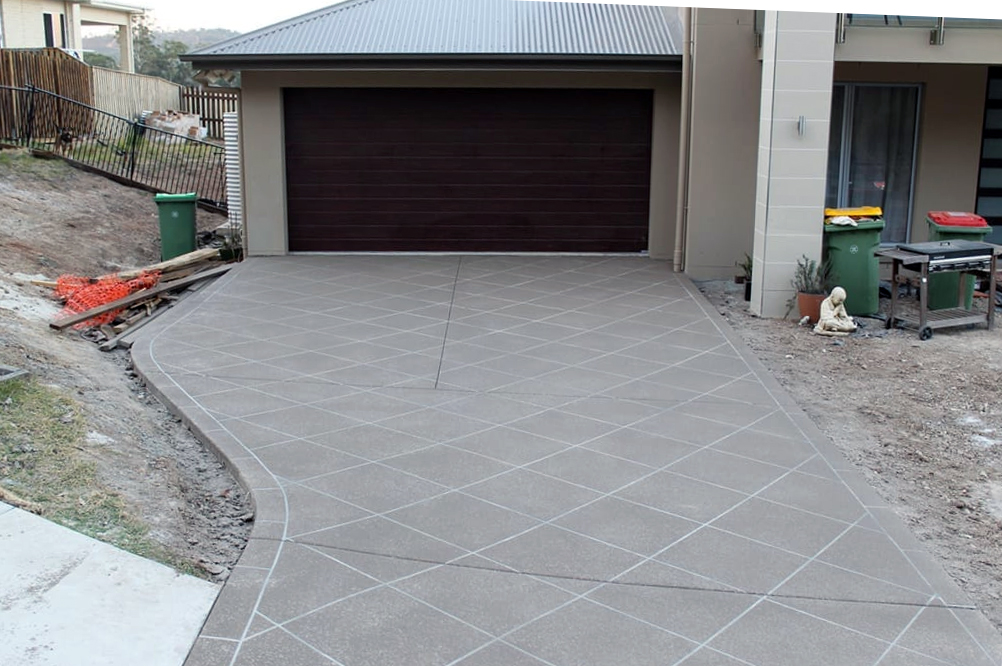
So, we’ve curated this guide with the best concrete driveway ideas to suit different landscapes and requirements.
Commonly Used Concrete Types
Before we take you through the different concrete driveway ideas, we thought it only makes sense for us to talk about the types of concrete used for the purpose. What’s more, cement driveways can easily be inlaid with other materials like brick and tiling without compromising durability. On that note, let’s dive in!
Perfect for Crossovers, pathways, and driveways!
1. Plain Concrete
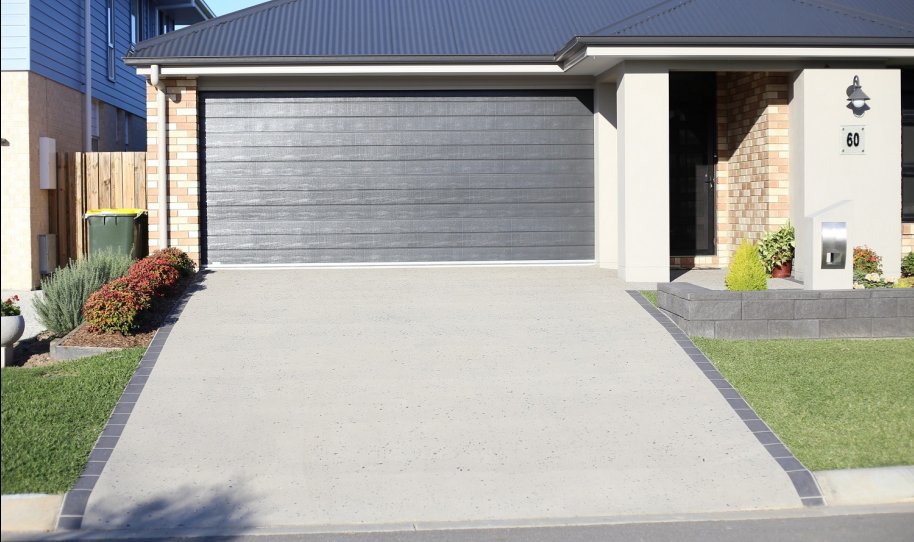
Undoubtedly, bare concrete is among the most used materials for driveways worldwide and not just in the country. But that’s not the only use of plain concrete that you will see. From footpaths to patios and buildings, the manifold utility of this material can be credited to the durability on offer.
But getting the best-quality concrete on the market isn’t the only step to ensure a long-lasting driveway. Some contractors like to use steel mesh to handle the material, but may fail to do so, especially if they are non-compliant. Hence, you must spend significant time searching for the right contractor with adequate experience and license.
2. Coloured Concrete

For people who want a well-built driveway minus the lack-lustre appearance of plain concrete, coloured concrete is the way to go! With a variety of colours to choose from, it’s a great choice for footpaths and driveways alike. And after opting for a vibrant base colour, you can discuss the other details with your contractor according to your preference and taste.
Usually, your contractor will provide you with a colour chart and also advice on creating customized colours. Beyond that, you may upgrade the existing plain concrete driveway to a coloured one.
Also, make sure that you’re fully aware of any special maintenance needs and procedures, if applicable. A manufacturer’s warranty is a good way to ensure that the coloured concrete stays vibrant and beautiful for prolonged periods.
Apart from that, concrete colouring employs one of the two techniques mentioned below:
3. Mixing Added Pigments
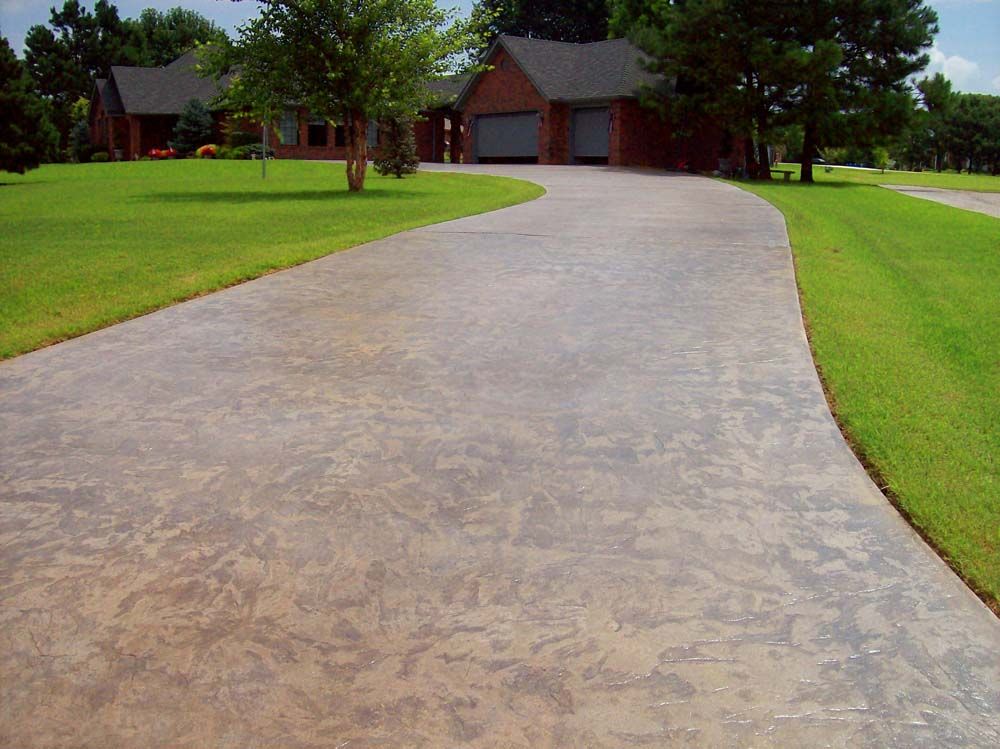
Colouring concrete by mixing added pigments is a fairly simple process. As the name suggests, the colour is achieved by mixing pre-made pigments to the concrete before pouring it on the driveway. Furthermore, the pigments are available in either a liquid form or mix-ready dissolvable bag, which is added to the mixer with the concrete ingredients.
One thing to keep in mind is that colours for this technique are mostly confined to earthy brown and tan tones, but you will also find vibrant shades of blue and green. Your contractor will know that pigmented concrete should always be sealed to prevent water infiltration from fading the colour.
4. Staining
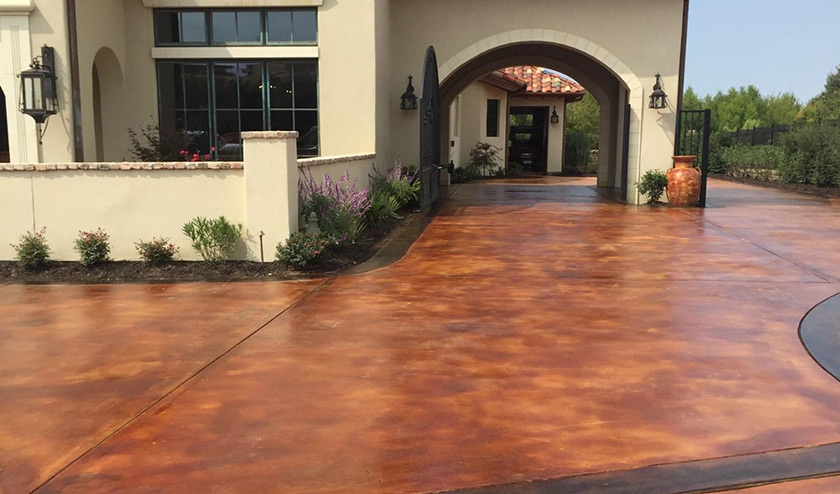
With no dearth of concrete staining products on the market, concrete staining is another commonly used technique primarily achieved through acid. A good thing about this process is that stains can be applied to concrete of any age. However, the colours will come out brighter if the stain is applied soon after the concrete is structured.
Similar to pigments, the range of stains is typically limited to subtle tones, but acrylic (water-based) generally offers more options, including black and white.
5. Stencilled Concrete
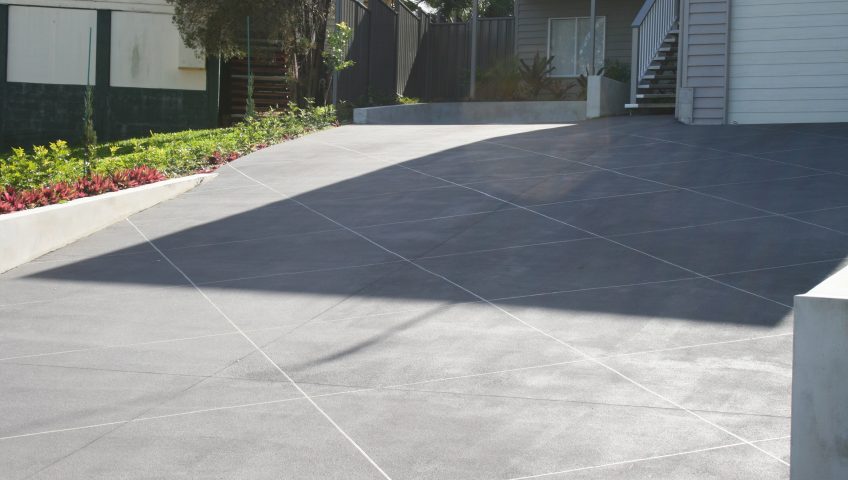
Stencilled concrete is perhaps the most sought-after choice for constructing a creative driveway. On top of that, homeowners are free to choose between various colours, patterns, and designs. And with the durability of concrete on offer, you can completely shift your focus to the aesthetic appeal.
As such, most contractors are equipped with dozens of options to suit different preferences, be it something elaborate or simple. They usually have a collection of standard concrete stencils, which can be customized or used as-is. The pattern is produced by exploiting the concrete surface once it has dried but is not fully hardened.
Another advantage of stencilled concrete is that it can be used in tandem with other materials like pavers, brickworks, slate, tiles, stone etc. to achieve distinct looks.
6. Exposed Aggregate
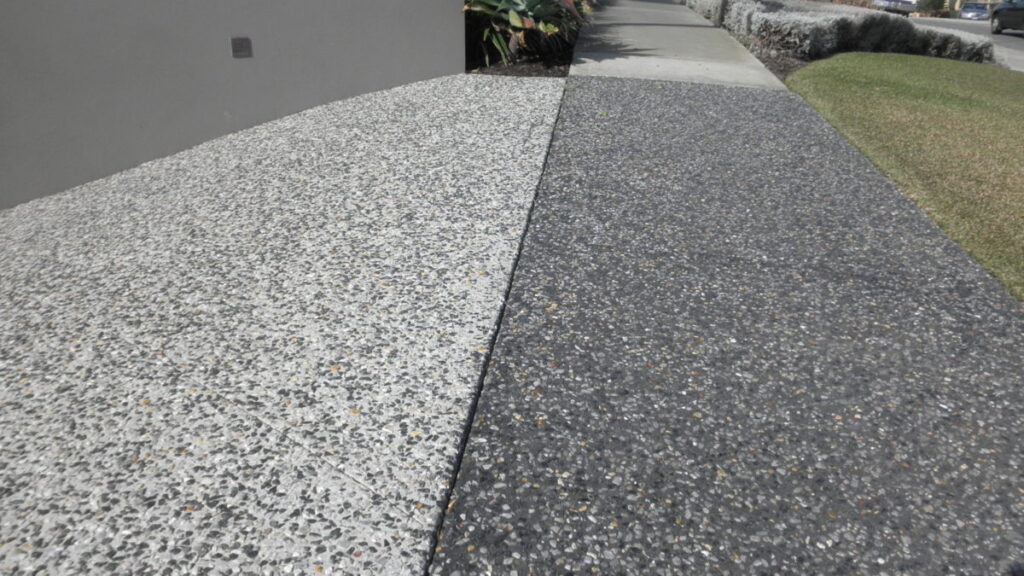
Exposed aggregate concrete driveways are becoming increasingly popular among homeowners who have durability on top of their priority list. Known for its stunning and robust finishes, this type of driveway is created by pouring concrete mixed with aggregates like pebbles, stones, shells, etc. Once in place, the mix is sanded back to reveal the texture of the embedded materials, which is surprisingly smooth.
Besides, several other techniques are used to achieve this effect, including high-pressure water washing with a hose, abrasive blasting, honing, acid etching, etc. At the end of it all, a sealant is applied to shield the finished surface.
The minimalist appearance will seamlessly blend with the natural surroundings and complement all-weathered, brick or rendered houses. But you can always opt for aggregates that best suit the exterior setup.
Exposed Aggregate should always be done by a professional, Our team of Melbourne concreters can help pour exposed aggregate for you.
Types Of Finishes
Now, let’s take a look at some in-demand concrete finishes and their respective techniques:
1. Trowelling Or Floating
One of the most basic concrete finishes is highlighted by a smooth surface created by screeds and trowels. Upon pouring the concrete in the form, finishers use a screed to level out the surface.
For the unversed, a screed is a long metal or wood that’s pulled and pushed across the surface to ensure a uniform distribution of the material. At the same time, it removes the accumulation of excess concrete. Once screeded, concrete finishers utilize a trowel for a second round of smoothening.
Much like a screeder, a trowel comprises a long, flat steel blade with a handle. That said, contractors use power trowels for larger areas where hand-held trowels aren’t feasible.
2. Edging
Edging of concrete surfaces is done to provide rounded or sloped edges for appearances or to create joints in the surface to prevent cracks. This process uses a special edging tool and requires considerable experience, so make sure your contractor has the necessary expertise.
3. Broom Finish
If you’re planning to make your concrete driveway fully slip-resistant, then consider a broom finish. After the concrete is trowled and levelled, a broom is dragged across the surface to create small ridges throughout. This creates a formidable traction control, especially when the surface is wet.
4. Stamped Finish
Most people relate concrete driveways with a stamped concrete finish or texture, simply because it provides durability and aesthetics like nothing else. Concrete stamps are essentially panels with inlaid designs placed on the surface while they are still curing.
The designs may consist of bricks, stone or any other pattern in accordance with the desired look. Furthermore, you may opt for building materials or coloured surfaces when the forms are removed.
5. Salt Finish
Much like broom finishing, salt finishing is achieved by applying rock salt to the wet concrete surface and washing it away. The wash-off leaves small pits on the driveway but doesn’t have a lot of traction.
6. Polished Finishing
Both newly placed or well-aged cured concrete can have a polished finishing. Not only does it provide a clean and glossy look, but it also aids maintenance and slip resistance.
This process is mainly achieved with the help of concrete floor grinders, which are fitted with different grades of diamond abrasives. The grade ranges from coarse to fine, and will ultimately determine the level of smoothness during polishing.
Especially for old concrete, the first step is to get rid of any existent sealers or coatings and simultaneously repair any visible cracks. It’s followed by the polishing process using a floor grinder.
Almost halfway through the polishing, chemical hardeners are added to the surface for prevention against water filtration in the future. And as the polishing proceeds, finer and finer abrasives are used to achieve as smooth a finishing as possible. An optional last step is to apply a sealing agent to protect the surface from oil, staining and moisture infiltration.
What Are The Factors That Influence The Cost Of Installing A Concrete Driveway?
Most contractors will measure the space in square-metres and quote a price accordingly. So, the larger the space, the more is the price. However, there are some other crucial factors that influence pricing, namely:
1. Slope
Rest assured that a sloping driveway will make the cost steeper! You may need about $10 extra per square metre if the concrete driveway is built on sloped terrain.
2. Prep Work
A majority of the homeowners wouldn’t expect their hired contractors to start building a driveway from the get-go. The prep work varies according to the area, and may range from cleaning the existing surface to excavating a lawn. Hence, the additional labour and machinery involved will contribute to the costs.
3. Type Of Concrete Being Used
Unsurprisingly, the type of concrete will dictate the building costs. And as is evident from our list, there are quite a few options to choose from, such as:
- Plain concrete- $65 to $90 per square metre
- Coloured concrete- $75 to $90 per square metre
- Stamping and exposed concrete- $100 to $150 per square metre
4. Additional Decorations
Patterns and designs like stencilling on new or existing concrete surfaces will invariably be charged extra. On top of that, incorporating landscape features like trees, a carport or gate will also rack up the final bill.
Pros Of Using Concrete For Building A Driveway
In a nutshell, here are the main advantages of having a concrete driveway:
1. Durability
Since concrete is used for massive building projects, its durability and weather-resistant properties are virtually unmatchable. Moreover, it can hold form even through natural disasters.
2. Versatility
Being a versatile material, it can be stamped and transferred into various patterns using almost any material. Plus, concrete can be stained to achieve any colour.
3. Reduced Maintenance
By employing the correct finishing, you can reduce the maintenance costs and efforts in the long run.
Cons Of Having A Concrete Driveway
For all things good, concrete isn’t free from its share of disadvantages in the long run.
1. Cracked Driveways
Despite being durable, concrete tends to crack over time due to various reasons like lack of control joints, inadequate strength, rapid drying, or excessive water use. Moreover, if the sealant isn’t of good quality, oil or chemical stains can seep through to weaken the construction from within. That said, there are numerous preventive measures to reduce the risk of cracking.
2. Expensive
Although cost-effective, concrete isn’t the most affordable material for building a driveway. Gravel and asphalt cost less.
Tips To Reduce The Cost Of Building A Concrete Driveway
1. Do Your Research
Ask multiple contractors to furnish their price quotes. This will give you a good idea about the average cost in your area, which will come in handy during negotiation.
2. Look For The Right Time
If possible, carry out the job during an “off-season” for builders. Generally, it’s advisable to avoid building a driveway during spring or autumn as these times are considered the peak season for contractors across the country. Aside from that, poor weather can slow down the process.
3. Buy Your Own Concrete
If you have sufficient knowledge about concrete, try to procure the materials on your own and leave only the construction part to professionals. But make sure you buy only the best quality materials.
Conclusion
That’s all from us for today!
Whether you’re planning to add a driveway to your property or resurfacing the existing one, it’s not something you’d want to do in a hurry. After all, no one likes spending their hard-earned money for nothing! That’s why it’s imperative to set aside sufficient time to make a decision. Especially if you’re a first-timer, we’d strongly recommend consulting a professional service for the job.
With that, it’s time for us to take our leave. We hope that we have helped you build the driveway of your dreams within your budget.
Till another day, chao!

